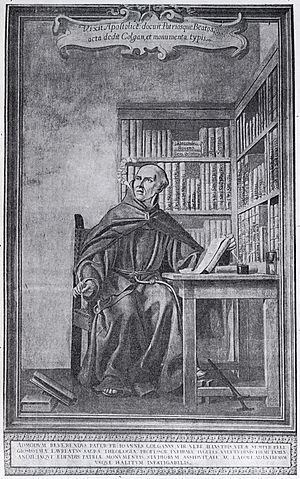John Colgan facts for kids
Quick facts for kids John Colgan |
|
|---|---|
| Seán Mac Colgan | |

John Colgan in a fresco created by Emmanuel di Como in St. Isidore's College, Rome, c. 1670
|
|
| Religion | Christianity |
| Order | Franciscan |
| Education | Irish Franciscan College of St Anthony of Padua in Leuven |
| Personal | |
| Nationality | Irish |
| Born | 1592 Priestown, near Carndonagh, County Donegal, Ireland |
| Died | 15 January 1658 (aged 65–66) St Anthony's, Leuven |
| Religious career | |
| Works | Acta Sanctorum Hiberniae |
| Ordination | 1618 |
| Profession | Hagiographer and historian |
John Colgan (born around 1592 – died January 15, 1658) was an Irish Franciscan friar. A friar is like a monk, but they often live and work among regular people. John Colgan was famous for being a hagiographer and a historian. A hagiographer is someone who writes about the lives of saints.
Contents
A Life of Learning
John Colgan was born around 1592 in a place called Priestown, near Carndonagh in County Donegal, Ireland. When he was about 20 years old, he left Ireland to study in Europe. He became a priest in 1618.
In 1620, John Colgan joined the Franciscan Order. This is a group of Catholic religious people. He went to study at the Irish Franciscan College of St. Anthony of Padua in Leuven, a city in Belgium. One of his teachers there was Thomas Fleming.
Later, Colgan taught philosophy in a city called Aachen. In 1628, he taught theology in Mainz. Theology is the study of religious faith. He then returned to Leuven in 1634.
The Project of Irish Saints
St. Anthony's College in Leuven was important because it trained friars to go back to Ireland. Before Colgan arrived, two other friars, Hugh Ward and Patrick Fleming, had started a big project. They wanted to collect and save information about Irish history and culture. Their main goal was to write a complete history of all the Irish saints.
Hugh Ward sent people, like Michael O'Clery, to Ireland and other places. Their job was to find and copy old handwritten books, called manuscripts. Sadly, Ward died in 1635 before much of the work was finished.
John Colgan had already offered to help by copying saintly writings from different libraries. After Ward's death, Colgan became a professor of theology. He took over the important project of writing about Irish history and saints. He was very good at the Irish language, which helped him understand the old manuscripts.
Colgan's Major Works
John Colgan started a huge project. He planned to publish six books about Irish church history and old traditions.
Lives of Irish Saints
In 1645, he published his first major book in Louvain. It was called Acta Sanctorum Hiberniae. This book contained the life stories of Irish saints whose feast days were in January, February, and March. A man named Hugh O'Reilly (Archbishop of Armagh) helped pay for some of the costs.
His second book came out in 1647. It was called Acta Triadis Thaumaturgae, which means "The Acts of a Wonder-Working Triad." This book focused on the three most important saints of Ireland: Patrick, Brigid, and Columbcille. For a long time, this book was almost the only source of information about Saint Patrick. Colgan's old teacher, Thomas Fleming, who was now the Archbishop of Dublin, paid for most of this book.
Besides the lives of saints, this book also had many useful "Appendices." These were extra sections that talked about old Irish church traditions and notes about places. Even if they weren't always perfect, they were very helpful for students.
In 1655, Colgan published a book about Duns Scotus. Duns Scotus was a famous Franciscan scholar. Colgan wanted to prove that Duns Scotus was born in Ireland, not England.
John Colgan stopped teaching in 1652. He died at St. Anthony's College in Leuven on January 15, 1658, when he was 66 years old.
Why Colgan's Work Matters
John Colgan's work on Irish saints is very valuable. Even though he was often sick, he was very smart and worked incredibly hard. He had a good sense for checking facts.
Because he knew the Irish language so well, he could use the huge collection of old manuscripts that Hugh Ward had started. Many of these manuscripts were later lost, so Colgan's copies are sometimes the only ones left! He also knew a lot about the stories and traditions of Irish people in his time. This gave him an advantage over writers who came later.
Today, there is an event called the Colgan Heritage Weekend. It is held every year in Carndonagh, County Donegal, which was his hometown.
Colgan's Main Books
- Acta Sanctorum Hiberniae (published in Louvain, 1645)
- Acta Triadis Thaumaturgae (published in Louvain, 1647)
- Tractatus de Vita, Patria, Scriptis Johannis Scoti, Doctoris Subtilis (published in Antwerp, 1655)
He also left behind many handwritten books that were never fully published. Some of these old manuscripts are now kept at University College Dublin.

